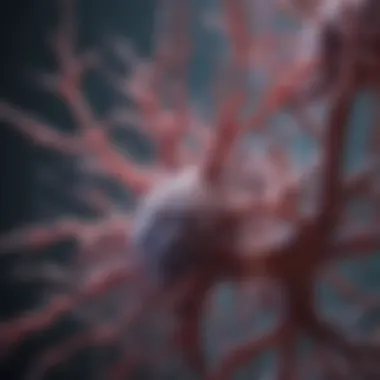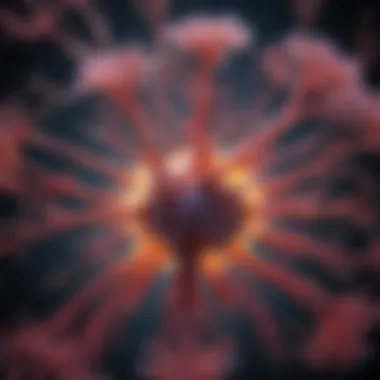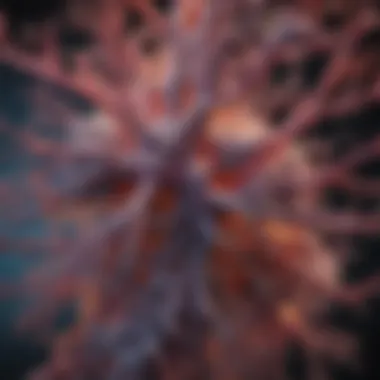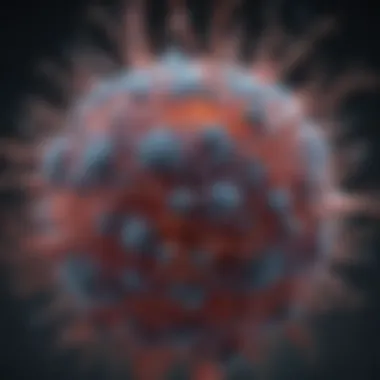Investigating PLX5622: Impact on Microglia and Neurodegeneration


Intro
The exploration of microglia, the central nervous system's resident immune cells, has gained significant momentum in contemporary neuroscience. Among the compounds being investigated is PLX5622, a selective inhibitor that holds promise for modifying microglial activity. This article aims to unravel the complexities surrounding PLX5622 and its potential applications in treating neurological disorders characterized by neuroinflammation and degeneration.
Microglia are pivotal to maintaining homeostasis in the brain. They respond to various stimuli with activation and can influence neurodevelopment, response to injury, and neurodegenerative processes. Thus, understanding how PLX5622 interacts with microglia is vital for identifying therapeutic strategies.
Research Overview
Summary of Key Findings
Recent studies suggest that PLX5622 specifically targets and inhibits microglial activation. This action can modulate inflammatory pathways that are often dysregulated in neurological conditions such as Alzheimer’s disease and multiple sclerosis.
Key findings include:
- Mechanisms of Action: The compound functions primarily by inhibiting the colony-stimulating factor 1 receptor (CSF1R), which is essential for microglial survival and proliferation.
- Efficacy: Preclinical models indicate that treatment with PLX5622 leads to a reduction in neuroinflammatory markers. Moreover, it has shown potential in improving cognitive functions in animal models of neurodegeneration.
- Safety Profiles: Initial assessments suggest that PLX5622 has a manageable safety profile, although long-term implications require further investigation.
Importance of the Research in Its Respective Field
The study of PLX5622 is essential for several reasons. First, it underscores the evolving understanding of microglial roles in pathology rather than mere context. Second, it offers insight into targeted therapies that could change how conditions like Alzheimer’s and Huntington’s disease are managed. The implications could reshape therapeutic paradigms by prioritizing microglial modulation as a strategy.
Methodology
Description of the Experimental or Analytical Methods Used
The methodology for assessing PLX5622's efficacy involves a combination of in vitro and in vivo studies. Research models range from cellular assays in isolated microglia to comprehensive assessments involving transgenic animal models that mimic human diseases. Techniques often used include:
- Flow cytometry for analyzing microglial phenotypes
- Western blotting to assess protein expression related to inflammation
- Behavioral assays to evaluate cognitive impact
Sampling Criteria and Data Collection Techniques
Sampling for in vivo studies typically includes both commercially available and genetically modified rodent models. Data collection encompasses:
- Measuring biomarkers from blood and brain tissue samples
- Observational data from cognitive assessments that analyze the effects of PLX5622 on behavior.
The comprehensive research endeavors to systematically address how PLX5622 engagement influences microglial function and its overall impact on neuroinflammatory pathways.
Modulating microglial behavior with PLX5622 could lead to significant advancements in managing neurodegenerative diseases.
Preface to Microglia
Understanding microglia is crucial when examining neurodegenerative diseases and the role of inflammation in the central nervous system. Microglia are the brain's primary immune cells and serve as the first line of defense against pathogens and injury. This article investigates PLX5622 and its selective targeting of microglia, which may lead to important therapeutic advances in treating various neurological disorders.
In this section, we will define microglia and explore their functional roles within the central nervous system. The discussion will provide insights into how these immune cells contribute to homeostasis, respond to injury, and play a key role in neuroinflammation.
Defining Microglia
Microglia are specialized macrophages residing in the central nervous system. They originate from yolk sac progenitors during early embryonic development and integrate into the brain, where they exist in a unique state distinct from the peripheral immune system cells. They are small, amoeboid-shaped cells that perform a variety of functions essential for maintaining neuronal health.
Their definition extends beyond mere structural features to encompass their dynamic interactions with neurons and other glial cells. By understanding microglia at this fundamental level, we can appreciate its significant role in normal brain physiology as well as pathophysiology.
Microglial Functions in the Central Nervous System
Microglia fulfill several functions in the central nervous system, acting as crucial support cells. Two main roles include their involvement in immune response and maintaining homeostasis and maintenance within neural environments.
Role in Immune Response


The role of microglia in the immune response is vital. These cells can detect and react to harmful stimuli such as pathogens or cellular debris. They express various receptors that recognize damage-associated molecular patterns, enabling them to respond swiftly. This activity can result in the release of pro-inflammatory cytokines, which help recruit other immune cells to the site of injury.
A key characteristic of this role is the rapid activation of microglia. This is both a strength and a concern since excessive activation can lead to chronic inflammation, contributing to neurodegenerative conditions. Understanding the balance microglia must maintain between defense and overactivation is essential for potential therapeutic approaches against related diseases.
Homeostasis and Maintenance
Homeostasis and maintenance are crucial for brain health, where microglia maintain the delicate balance of neuronal signaling. These cells help with synaptic pruning during development and regulate neuronal activity in mature brains. Microglia can also respond to oxidative stress and provide neurotrophic support, which is necessary for neuronal survival.
This ability makes microglia a beneficial focus of research within this article. However, their response must be carefully regulated; an imbalance can hinder neuronal function and contribute to various psychiatric and neurodegenerative disorders.
Understanding microglial functions is pivotal as we begin to explore the impact of PLX5622 on these cells. Modulating microglial activity may offer novel strategies in treating conditions marked by inflammation and neurodegeneration.
Overview of PLX5622
Understanding PLX5622 is crucial as it provides insight into how this compound can potentially alter microglial behavior. Microglia are integral to the immune responses in the central nervous system, and targeting them effectively can have significant repercussions in treating neurological disorders. PLX5622 is noteworthy due to its selective targeting, which minimizes damage to other cell types while potentially enhancing the therapeutic outcomes in various conditions.
Chemical Composition and Properties
PLX5622 is a small molecule that belongs to the class of compounds known as CSF1R inhibitors. Its chemical structure is optimized to facilitate penetration across the blood-brain barrier, maximizing its accessibility to microglia. This specificity in design ensures that it primarily interacts with its target without extensively affecting other cell populations.
Moreover, its solubility in biological fluids enhances its practical application in therapeutic settings. Researchers have noted the importance of bone-marrow-derived macrophages and microglial responses to this compound, demonstrating that its application can influence systemic and neural immunity. Thus, understanding its composition is key to appreciating its role in potential therapeutic contexts.
Mechanism of Action
The mechanism of action of PLX5622 involves intricate pathways that govern microglial function.
Targeting CSF1R
Targeting the colony-stimulating factor 1 receptor (CSF1R) plays a pivotal role in the behavior modification of microglia. PLX5622 binds to CSF1R, inhibiting its signaling pathways that typically promote microglial survival and proliferation.
This selective action is a primary characteristic of PLX5622. By blocking CSF1R, it prevents the survival signals that often contribute to chronic inflammation. Thus, this characteristic makes it an effective choice for research that aims at understanding various neuroinflammatory diseases. In addition, its capacity to limit microglial expansion means that there is a reduced risk of excessive immune activation, which often worsens neurological conditions.
Inhibition of Microglial Proliferation
The inhibition of microglial proliferation is another important aspect of PLX5622's impact. By limiting the number of microglia, PLX5622 contributes to a balanced immune response. This ability to control cell growth is essential for maintaining homeostasis in the central nervous system.
This feature makes PLX5622 a beneficial candidate for research into disorders where microglial overactivation contributes to pathology. The advantages of this inhibition include not just reduced inflammation but also prevention of neurodegeneration that often occurs due to activated microglia. However, there are concerns regarding the long-term effects of reduced microglial numbers, as these cells also play a role in tissue repair and maintaining neuronal health.
In summary, PLX5622 represents a significant advancement in how we can selectively target microglial activity. The chemical properties, coupled with its distinct action on CSF1R and its effect on microglial proliferation, make it worthy of further investigation as a therapeutic agent for various neurological conditions.
Impact of PLX5622 on Microglial Cell Activity
The impact of PLX5622 on microglial cell activity is significant in understanding the broader implications for neurological health. Microglia, as the primary immune cells in the brain, play a major role in maintaining homeostasis and responding to injury. The selective targeting of microglia by PLX5622 has opened new avenues for therapeutic interventions in neuroinflammatory conditions and neurodegenerative diseases.
In this section, we explore how PLX5622 alters microglial behavior, specifically in terms of inflammation reduction and phagocytic processes. Understanding these effects allows researchers to anticipate potential clinical outcomes and guides the development of future therapies.
Effects on Inflammation
Reduction of Pro-inflammatory Cytokines
The reduction of pro-inflammatory cytokines is a key outcome of PLX5622 treatment. Pro-inflammatory cytokines, such as IL-1β and TNF-α, are pivotal in the neuroinflammatory process. They not only signal the presence of issues in brain function but also can exacerbate neuronal damage when produced in excess. By inhibiting their release, PLX5622 aims to stabilize the neuroinflammatory environment.
The significant characteristic of this reduction is its dual benefit. It not only mitigates immediate inflammatory responses but also fosters long-term neuroprotection. The interconnected nature of inflammatory signaling means that lowering these cytokines may contribute to reduced neuronal apoptosis and improved overall brain health.
One unique feature of this reduction is its potential broad applicability across various neurological conditions. For instance, in diseases like Alzheimer’s, the chronic presence of pro-inflammatory cytokines worsens the condition. PLX5622’s action can break this cycle, promoting better outcomes. However, caution is necessary, as an overly suppressed immune response could leave the brain vulnerable to infections.


Influence on Neuroinflammatory Diseases
The influence of PLX5622 on neuroinflammatory diseases is noteworthy. PLX5622 targets the root causes of inflammation at a cellular level, which may lead to significant improvements in diseases characterized by neuroinflammatory processes. Conditions like multiple sclerosis and traumatic brain injury could see benefits from this targeted treatment approach.
A key characteristic of influence in this context is its specificity. By acting primarily on microglia, PLX5622 minimizes collateral damage to surrounding neurons and other cell types. This specificity is advantageous as it allows for more focused therapeutic strategies.
The unique aspect of this influence is observable in its continued research implications. As more is learned about how PLX5622 alters microglial activity, it may guide additional treatments that combine this compound with others for a multi-faceted approach to neuroinflammation. However, its administration must be evaluated carefully, as the complex interplay of immune responses in the brain cannot be overlooked.
Modulation of Phagocytic Activity
The modulation of phagocytic activity is another primary impact of PLX5622 on microglia. Microglial cells serve as the brain’s cleanup crew, removing dead cells and debris to maintain neural health. PLX5622 enhances this function, leading to more efficient waste removal, which is crucial for maintaining an optimal environment conducive to neuronal health.
Phagocytosis is essential during neuroinflammation, as it removes the remnants of damaged cells and pathogenic agents. By improving microglia's ability to engage in phagocytosis, PLX5622 may contribute to the resolution of inflammation and support tissue remodeling after injury.
Notably, the modulation of this activity can have a positive feedback effect. As microglia clear cellular debris, the overall inflammatory environment improves, leading to a more stable and healthier brain. However, researchers must continue monitoring this modulation closely. Any excessive phagocytosis could inadvertently lead to further neuronal loss, so finding the right balance is critical in therapeutic contexts.
PLX5622's impact on microglial activity is not only relevant for understanding current treatments but also paves the way for innovative therapies aimed at reducing neuroinflammation and promoting brain health.
Therapeutic Potential of PLX5622
The exploration of PLX5622 presents significant implications for neurological diseases, especially in relation to its therapeutic potential. PLX5622 is captured within discussions of microglial modulation as a potential treatment option. Microglia play a critical role in the brain's homeostasis and immune response. Therefore, devising a strategy to manage their activity can lead to beneficial outcomes in various disorders. PLX5622 acts by specifically targeting CSF1R, which influences microglial proliferation and can diminish harmful inflammatory processes associated with neurodegeneration.
Neurodegenerative Diseases
Alzheimer's Disease
Alzheimer's disease is a prominent aspect of neurodegenerative research due to its prevalence and societal impact. PLX5622 offers a unique approach to understanding the neuroinflammatory component of Alzheimer's pathology. A key characteristic of Alzheimer’s is the accumulation of amyloid-beta plaques, which leads to microglial activation. The utilization of PLX5622 could potentially moderate this activation, thus presenting a beneficial avenue in treatment development.
Moreover, the unique feature of Alzheimer’s disease is how the immune response emerges and exacerbates neural degeneration. By investigating PLX5622’s effects, researchers aim to establish a clearer picture of how modulating microglial behavior can advance treatments for Alzheimer's patients.
Parkinson's Disease
Parkinson's disease also represents an urgent area for therapeutic exploration. It is characterized by motor dysfunction, attributed in part to the loss of dopaminergic neurons in the substantia nigra. Recent studies indicate that neuroinflammation has a substantial role in the progression of Parkinson's disease. PLX5622’s capacity to inhibit microglial proliferation can be beneficial, as it could reduce inflammatory factors that contribute to the degeneration of neurons.
The unique aspect of Parkinson's disease is the interplay of inflammation and neurodegeneration. PLX5622’s therapeutic potential in this context is significant. By targeting microglial activity, there is hope for delaying the disease's progression and enhancing quality of life for patients.
Psychiatric Disorders
Depression
Depression is a widespread mental health condition, potentially linked to neuroinflammatory processes. The significance of PLX5622 emerges as studies suggest that microglial activation correlates with depressive states. Research focusing on this area is vital to understand how manipulating microglia can help in alleviating symptoms of depression.
A critical characteristic of depression is its multifaceted nature, intertwining biological, psychological, and social factors. PLX5622’s ability to alter inflammatory markers associated with depression presents it as a valuable research avenue. Its unique feature lies in potentially offering a biological intervention that fits into the broader spectrum of treatment methodologies.
Anxiety
Anxiety disorders are another prominent area where PLX5622 may demonstrate therapeutic potential. Chronic stress and anxiety have been shown to provoke significant changes in microglial activity, which can contribute to the severity of these conditions. PLX5622's role in modulating this microglial response opens new doors for treatment through a biological lens.
The key characteristic of anxiety lies in its persistent nature and its relationship with stress pathways. PLX5622's unique attribute is its specific intervention on the immune response, aiming to provide relief and a more stable emotional state for individuals suffering from anxiety disorders. Thus, understanding the implications of this compound could significantly influence future treatment strategies.
"The relationship between microglial activity and emotional regulation opens fascinating avenues for potential therapies in psychiatric disorders, highlighting the therapeutic potential of targeted interventions such as PLX5622."
Overall, the therapeutic potential of PLX5622 spans across various disorders, emphasizing its capacity to reshape current treatment landscapes in neurodegenerative and psychiatric conditions.
Challenges and Limitations


Understanding the challenges and limitations associated with PLX5622 is crucial for a comprehensive review of its applications in clinical settings. This section aims to delve into two primary areas: safety issues related to PLX5622 and obstacles that arise during clinical applications. Addressing these fundamental aspects not only assists in evaluating the potential of the drug but also outlines the broader theme of microglial modulation in therapeutic strategies.
Safety and Side Effects
PLX5622 has demonstrated specific efficacy in targeting microglial cells, but the safety profile must warrant thorough investigation. Concerns regarding side effects can significantly affect its clinical acceptance. Even minor adverse effects might influence patient adherence and willingness to undergo treatment. High-quality pre-clinical and clinical studies are essential to identify and assess these side effects comprehensively.
Moreover, while PLX5622 exhibits a favorable profile in terms of side effects in initial studies, further research is needed to explore the long-term effects of microglial depletion. Understanding the balance between therapeutic effects and potential risks is paramount in shaping public and clinical opinion on this compound.
Challenges in Clinical Application
The road from preclinical studies to patient treatment involves a multitude of hurdles. In this context, the challenges in clinical application can be examined through two specific lenses: regulatory hurdles and patient variability.
Regulatory Hurdles
Regulatory hurdles represent a significant barrier to the successful translation of PLX5622 from laboratory research to clinical practice. The intricate process of obtaining approval from regulatory bodies such as the Food and Drug Administration (FDA) involves comprehensive documentation, including safety profiles, efficacy data, and clear study designs. The stringent requirements can delay the availability of PLX5622 for patients in need, creating a gap between research advancements and practical applications.
Key characteristics of these regulatory hurdles often revolve around the need for extensive evidence regarding the long-term safety and efficacy of new treatments. This necessity emphasizes a cautious approach to innovation in pharmaceuticals, posing potential advantages in protecting patient welfare, but it also serves as a frustrating element for researchers eager to see their findings applied for therapeutic use.
Patient Variability
Patient variability is another critical aspect influencing the clinical application of PLX5622. Each individual’s distinct biological makeup can lead to different responses to treatment. Variations in genetics, comorbid conditions, and lifestyle factors all contribute to this complexity.
Recognizing this variability is essential, as it underscores the challenges in designing clinical trials that can sufficiently represent the population as a whole. Accounted patient variability can lead to unexpected results during trials, which may obscure the true efficacy or safety of the drug. Therefore, understanding how patient differences can impact the outcomes of PLX5622 treatments is a pivotal consideration for future research.
Current Research and Future Directions
Research on PLX5622 is evolving continuously. It is important to understand the current status of clinical trials and further applications in therapy for neurodegenerative diseases and others. As science progresses, knowledge about safe and effective treatment methods becomes vital. Insights gained from ongoing studies inform the future integration of PLX5622 into clinical practice. This direction will not only shape the therapeutic landscape but also refine our approaches to treating neurological conditions effectively.
Ongoing Clinical Trials
Ongoing clinical trials are instrumental in evaluating the effectiveness of PLX5622 in different populations. These trials focus on various neurological conditions, providing necessary data about dosing, safety, and patient responses. For instance, many are centered around Alzheimer’s and Parkinson’s diseases, assessing how well this compound reduces neuroinflammation and improves cognitive functions. The data gathered can lead to modifications in dosing schedules and treatment protocols, enhancing overall patient care. Additionally, the trials contribute to understanding patient variability within diverse demographic groups, which is essential for tailoring treatments appropriately.
Potential Combinations with Other Therapies
Exploring combinations of PLX5622 with other therapies opens avenues for improved efficacy. Two notable areas of combination therapies include Immunotherapy and Neuroprotective Agents.
Immunotherapy
Immunotherapy has attracted attention for its unique approach in the realm of neurological disorders. One specific aspect is its potential to orchestrate a more comprehensive immune response, enhancing the benefits of PLX5622. The key characteristic of immunotherapy is its ability to boost the immune system’s capacity to eliminate pathological processes. This makes it an appealing choice when looking at treating neurodegenerative diseases, as it can work synergistically with PLX5622 to fine-tune microglial responses.
The unique feature of immunotherapy is its focus on modulating immune cells for a better reaction against diseases. One advantage of combining immunotherapy with PLX5622 is the increased potential to reduce inflammation further. However, challenges may arise in terms of managing immune-related side effects, which can complicate regimens.
Neuroprotective Agents
Neuroprotective Agents hold a significant position in the therapeutic arena for defending neurons against injury and degeneration. Their specific role in this context is centered on enhancing neuroprotection alongside the actions of PLX5622. The key characteristic of neuroprotective agents lies in their ability to prevent neuronal loss, which is crucial in conditions like Alzheimer’s and multiple sclerosis.
Integrating neuroprotective agents into therapy with PLX5622 provides a dual mechanism, targeting both microglial activity and protecting neurons directly. A unique feature of these agents is their varied mechanisms of action, which can help in fine-tuning treatment as per the patient's needs. Nevertheless, choosing appropriate neuroprotective agents poses risks, including potential interactions with PLX5622 that need careful evaluation.
"The intersection of PLX5622 with immunotherapy and neuroprotective agents may revolutionize treatment strategies, making them more effective and tailored to individual patients."
In summary, the exploration of ongoing studies and potential combinations with established therapies indicates promising directions for future research. Continued investigation will provide insights that enhance our understanding of PLX5622's roles, ensuring that we are equipped to address the complexities of neurological disorders.
End
The conclusion serves as a pivotal point in this article, encapsulating the significance of PLX5622 in relation to microglial activity in the central nervous system. This novel compound reveals promise in addressing numerous neurodegenerative disorders. By summarizing the key points discussed, we can draw attention to the transformative potential of PLX5622 and its implications for future research and therapy.
Summarizing the Role of PLX5622
PLX5622 primarily targets the colony-stimulating factor 1 receptor (CSF1R) on microglia, inhibiting their proliferation. This action decreases the number of activated microglia in the brain, potentially reducing inflammation associated with neurodegenerative diseases. Research indicates that PLX5622 usage correlates with lowered levels of pro-inflammatory cytokines, further supporting its beneficial effects in inflammatory conditions. The precise modulation of microglia can help restore homeostasis within the central nervous system, and thereby improve neuronal health. As such, understanding the role of PLX5622 is essential for harnessing its therapeutic capability in various neurological disorders.
Implications for Future Research
The implications for future research are significant. Current studies involving PLX5622 lay the groundwork for more comprehensive clinical trials. There is a need to explore into the optimal dosing strategies and potential combinatory therapies that incorporate PLX5622 with existing treatments. This might include the integration of immunotherapy and neuroprotective agents to bolster efficacy against chronic neurological conditions. Moreover, understanding the long-term impacts of microglial modulation remains a crucial area of inquiry, as it can lead to improved safety profiles and enhanced patient outcomes. The avenue of investigation regarding PLX5622 opens the possibility for innovative strategies in treating complex neurodegenerative and psychiatric disorders.







